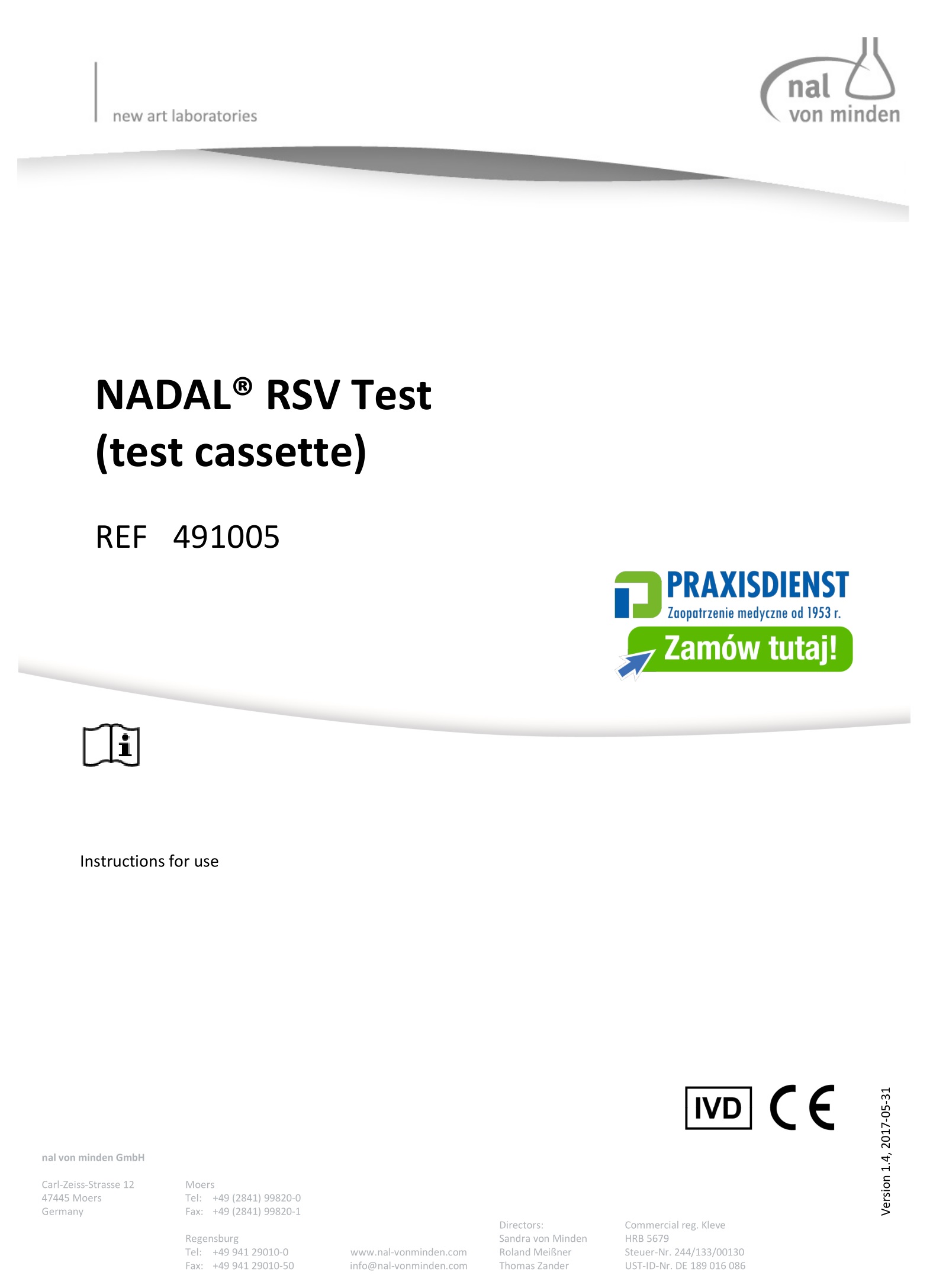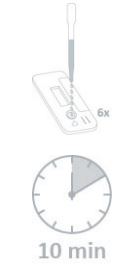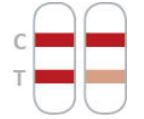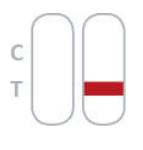Instruction Manual of PRAXISDIENST 491005 Nadal RSV Test

www.nal-vonminden.com
info@nal-vonminden.com
Intended Use
The NADAL® RSV Test is a lateral flow chromatographic immunoassay for the qualitative detection of respiratory syncytial virus (RSV) in nasopharyngeal aspirates and swabs. This test is intended for use as an aid in the diagnosis of respiratory tract infections caused by RSV and is designed for professional use only.
Introduction and Clinical Significance
RSV is the most common respiratory virus in infants and young children. It infects virtually all children by the age of two. In most children, the virus causes symptoms resembling those of the common cold. In infants born prematurely and/or with chronic lung disease, RSV can cause a severe or even life threatening disease. Prior to the introduction of Synagis®, RSV disease resulted annually in over 125,000 hospitalisations. There was a high mortality risk amongst approximately 2% of infants. Symptoms of RSV can include fever, runny nose and other more serious symptoms like coughing, difficult and rapid breathing or wheezing.
Test Principle
The NADAL® RSV Test is a lateral flow chromatographic immunoassay for the qualitative detection of RSV (respiratory syncytial virus) in nasopharyngeal aspirates and swabs.
A combination of monoclonal antibody-dye conjugates and polyclonal solid phase antibodies is used in the NADAL® RSV Test to selectively detect RSV with a high degree of sensitivity and specificity.
After collection and treatment of a sample, a few drops of it are added to the sample well (⇒) of the test cassette.
As the sample migrates along the membrane, antibody-dye conjugates bind to RSV antigens (if they are present in the sample), forming antibody-antigen complexes. In the case of a positive result, these complexes bind to polyclonal antibodies in the test line region of the test cassette and produce a pinkrose line. In the absence of RSV, no line appears in the test line region of the test cassette. The reaction mixture continues migrating along the membrane of the test cassette. Unbound conjugates bind to the reagents in the control line region, producing a pink-rose line, which demonstrates that the proper volume of specimen has been added and membrane wicking has occurred.
Reagents and Materials Supplied
- 20 NADAL® RSV test cassettes
- 20 disposable pipettes
- 20 swabs
- 2 bottles of Buffer (11 ml)
- 1 package insert
Additional Materials Required
- Timer
- Plastic tube (for min. 1 ml buffer)
- 0,5 ml-pipettes
- 1 ml-pipettes (if necessary)
- Appropriate dilution medium (e.g. sterile saline, for aspirates)
- Catheter or mucus trap (for aspirates)
Storage & Stability
NADAL® RSV test kits should be stored at 4-30°C and used by the expiry date indicated on the package. Do not freeze test kits. Do not use tests beyond the expiry date.
Warnings and Precautions
- For professional in-vitro diagnostic use only.
- Carefully read through the test procedure prior to testing.
- Do not use the test beyond the expiration date indicated on the package.
- Do not use the test if the foil pouch is damaged.
- Do not reuse tests.
- Do not add samples to the reaction area (result area).
- In order to avoid contamination, do not touch the reaction area (result area) or the immersion area.
- Avoid cross-contamination of specimens by using a new extraction tube for each specimen obtained.
- Do not substitute or mix components from different test kits.
- Clean up spillage thoroughly, using an appropriate disinfectant.
- Do not eat, drink or smoke in the area where specimens and test kits are handled.
- Wear protective clothing such as laboratory coats, disposable gloves and eye protection when specimens are being assayed.
- Handle all specimens as if they contain infectious agents. Observe established precautions for microbiological risks throughout all procedures and standard guidelines for the appropriate disposal of specimens.
- The test kit contains products of animal origin. Certified knowledge of the origin and/or sanitary state of the animals does not completely guarantee the absence of transmissible pathogenic agents. It is therefore recommended that these products be treated as potentially infectious, and handled in accordance with usual safety precautions (e.g., do not ingest or inhale).
- Humidity and temperature can adversely affect test results.
- Used testing materials should be discarded according to local regulations.
Specimen Collection and Preparation
Notes:
- RSV samples should be taken almost exclusively from the respiratory tract.
- Use a mucus trap or a catheter to collect nasopharyngeal aspirate sample.
- Nasopharyngeal swabs may also be used with this test. However, they are somewhat inferior to nasopharyngeal aspirate samples.
- If a swab is not tested immediately, it should be stored in a clean and dry container (not supplied) at 2-8°C and tested within the next 24 hours.
- Do not use any holding medium.
Nasopharyngeal aspirate
- After sample collection using a suitable procedure, dilute the nasopharyngeal aspirate with appropriate medium (e.g. sterile saline) up to a maximum volume of 3 ml.
- Add 1 ml of the diluted sample (or 2 x 0.5 ml) to a plastic tube and centrifuge for 10 minutes at 3,500 rpm.
- Discard the supernatant and resuspend the pellet in 0.5 ml of buffer. Using the pipette, mix the suspension well by repeated up and down pipetting.
- Allow the extraction solution to stand for 15 minutes before performing the test.
Nasopharyngeal swab
- Collect a nasopharyngeal swab sample, using provided swabs or sterile swabs with rayon or dacron tips. (Note: Do not use swabs with cotton or calcium alginate tips, wooden shafts or impregnated with charcoal or transport media containing agar or gelatin).
- Immediately after collection, immerse the swab into a plastic tube with added 1 ml of Buffer (or 2 x 0.5 ml) and swirl the swab vigorously for 10 seconds to ensure adequate extraction.
- Allow the extraction solution to stand for 15 minutes.
- At the end of the extraction time, squeeze the liquid from the swab thoroughly by pressing it against the tube wall.
- Discard the swab in accordance with standard guidelines for the appropriate disposal of infectious materials.
Test Procedure
Bring tests, specimens, buffer and/or controls to room temperature (15-30°C) prior to testing.

- Remove the test cassette from the sealed foil pouch and use it as soon as possible.
- Holding the pipette vertically, dispense 6 drops (200 µL) of the extracted solution into the sample well (⇒).
- Start the timer.
- Read the test result exactly 10 minutes after adding the extracted solution to the sample well.
Result Interpretation
Positive

Two coloured lines appear. One coloured line appears in the control line region (C) and the other coloured line appears in the test line region (T).
Negative

Only one coloured line appears in the control line region (C). No coloured line appears in the test line region (T).
Invalid

The control line fails to appear. Results from any test which has not produced a control line at the specified reading time must be discarded. Please review the procedure and repeat the test with a new test cassette.
If the problem persists, discontinue using the test kit immediately and contact your local distributor. Insufficient specimen volume, incorrect operating procedure or expired tests are the most likely reasons for the control line failure.
Quality Control
An internal procedural control is included in the test strip:
A coloured line appearing in the control line region (C) is considered an internal procedural control. It confirms sufficient specimen volume, adequate membrane wicking and correct procedural technique.
Good laboratory practice (GLP) recommends the use of control materials to ensure proper test kit performance.
Limitations
- The NADAL® RSV Test is specifically designed for the qualitative detection of RSV in nasopharyngeal aspirates and swabs.
- As with any diagnostic procedure, the physician should evaluate data obtained with the NADAL® RSV Test in conjunction with other clinical methods.
Performance Characteristics
Accuracy
A study was performed on 49 positive, nasopharyngeal aspirate samples obtained from children suffering from RSV type bronchiolitis (RSV A, RSV B or non-identified RSV) and on other 47 nasopharyngeal aspirates free of virus.
The results obtained with the NADAL® RSV Test were compared with immunofluorescence results obtained using the IMAGEN RSV kit (DAKO).
RSV-positive and RSV-negative clinical samples were tested using the NADAL® RSV Test and confirmed with immunofluorescence and a culture method.

Relative sensitivity: 86% (42/49)
Relative specificity: 94% (44/47)
Overall agreement: 90% (86/96)
One sample, not included in the table above, was found negative by immunofluorescence method and found positive using the NADAL® RSV Test. It was confirmed as a positive sample by PCR method.
Cross-reactivity
Nasopharyngeal aspirates positive for parainfluenza virus (2 samples), rhinovirus (7 samples) or adenovirus (2 samples) were tested, using the NADAL® RSV Test and repeatedly showed negative results, while the presence of the aforementioned viruses in the samples was confirmed either by cell culture or immunofluorescence methods.
References
- Chanock, R.M., and L. Findberg. 1957. Recovery from infants with respiratory illness of a virus related to chimpanzee coryza agent (CCA). II. Epidemiologic aspects of infection in infants and young children. Am. J. Hyg.66 : 291-300.
- Chanock, R.M., H.W. Kim, A.J. Vargosko, A. Deleva, K.M. Johnson, C.Cumming, and R.H. Parrott. 1961. Respiratory syncytial virus. I. Virus recovery and other observations during 1960 outbreak of bronchiolitis, pneumonia, and minor respiratory diseases in children. J. Am. Med. Assoc. 176 : 647-653.
- Hall, C.B, R.G. Douglas, and J.M. Geiman. 1976. Respiratory syncytial virus infections in infants: quantitation and duration of shedding. J. Pediatr. 89 : 1443- 1447.
- Hall, C,B,J.T. McBride, E.E. Walsh, D.M. Bell, C.L. Gala, S.Hildreth, L.G. Teneyck, and WW.J. Hall. 1983. Aerosolized ribavirin treatment of infants with respiratory syncytial virus infection. N.Engl. J. Med. 308 : 1443-1447.
- Taber, L.H.V, Knight, B.E. Gilbert, H.W. McClung, S.Z. Wilson, H.J. Norton, J.M. Thurson, W.H. Gordon, R.L. Atmar and W.R. Schlaudt. 1983. Ribavirin aerosol treatment of bronchiolitis associated with respiratory syncytial virus infection in infants. Pediatrics 72 : 613-618.
- Ahluwalia, G.J. Embree, P. McNicol, B.Law, and G.W. Hammond. 1987. Comparison of nasopharyngeal aspirate and nasopharyngeal swab specimens for respiratory syncytial virus diagnosis by cell culture, indirect immunofluorescence assay, and enzyme-linked immunoabsorbent assay. J.Clin. Microbiol. 257 : 763-767.
Rev. 4, 2017-05-31 OM/UJa
